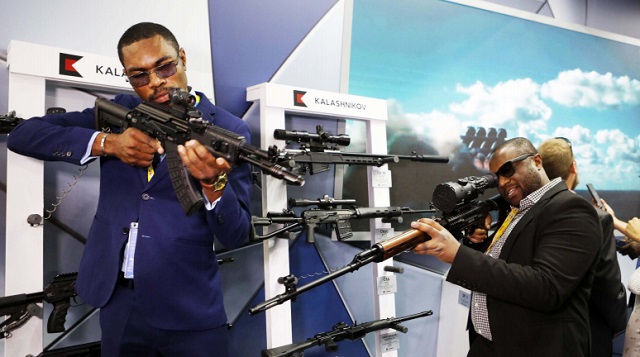
Russians versus Chinese
So far, Russia has been the biggest beneficiary in shipping arms to these countries and China is scrambling to catch up.
When some 40 African heads of state and their delegations descended on the Russian Black Sea city of Sochi this October, excitement over military cooperation and military hardware almost obscured deals in nuclear energy, oil, gas, agriculture, and diamonds.
“Give us guns; give us, we will pay later,” is how one journalist reported the excited chatter from African leaders in their pitches to Russian president Vladimir Putin and other Russian officials in sideline meetings.
Russia had laid out the military hardware favoured by African countries first as model tanks inside the chambers and as full scale tanks, helicopters, fighter jets, rocket launchers, and automatic rifles on the grounds outside.
Even Ethiopian Prime Minister Abiy Ahmed, recent winner of the Nobel Peace Prize, was photographed pensively eyeing model tanks.
Russia is the second largest supplier of arms in the world but, according to reliable reports, it leads in sales to Africa; supplying 39% of Africa’s imported arms between 2017 and 2013.
Nigeria reportedly bought 12 helicopters and signed a deal for training and other equipment, and other countries are negotiating more deals to add to the 21 military agreements signed in the last five years between Russia and Africa.
But between 2013 and 2017, Chinese arms sales increased by 38 per cent from the previous five-year period, with Africa accounting for 21 per cent of China’s arms exports, according the Stockholm International Peace Research Institute (SIPRI). The Chinese arms are picking up because they are easy to operate, effective, relatively cheap and boast similar features to the Russian weapons, according to military expert reports.
The SIPRI Arms Transfers Database shows that Uganda purchased most of its equipment from Russia, with biggest purchases happening in 2011. That is when it got the six famous SU-30mk aircraft in a US$635 million deal with accessories like guided bombs, Anti-ship missiles, and Anti-tank missiles. It also bought 32 BTR-80A Infantry Fighting Vehicles (IFV) and 44 TS-90s tanks.
These assets have given Uganda superior airpower compared to Rwanda, DRC, Burundi, South Sudan, and Tanzania. Only Kenya boasts more air fire power. Just recently, on Nov. 7, President Museveni graduated 18 Ugandan Air Force pilot cadets at the newly upgraded Gulu Air Base. The base has new training facilities, equipment, and aircraft. The ceremony featured flight demonstrations with Cessna 172 piston trainers and L-39 jets from Bulgaria.

Rwanda has made most of its military orders from Russia, followed by Israel, Turkey and China. Rwanda’s reported latest purchase of 50 Red Arrow-9 self-propelled Anti-Tank missiles from China were received in 2018. That made Rwanda the first foreign armed forces known to be equipped with China’s ‘Red Arrow’ anti-tank missiles. In 2017 it got 30 Cobra Armoured Protected Vehicles (APV) from Turkey, and six Mi-8MT/Mi-17 helicopters from Russia.
Rwanda has Russian helicopters, Ural vehicles, small arms, and Air Defense Systems. The two agreed military and technical cooperation in 2017. But Rwanda is equally receptive to the Chinese. The military parade celebrating Rwanda’s 25th Liberation Day in August was overseen by Chinese instructors from the People’s Liberation Army Honor Guard.
The data indicates that military expenditure in Rwanda increased to US$119.50 million in 2018 from US$115.70 million in 2017. Rwanda’s highest expenditure was US$158 million in 1991. Burundi also boasts some Russian APCs got in a 2012 deal.
The arms trade is, however, highly secretive. At one time it was revealed that the Israel-based agricultural company Green Horizon was a front for retired Israeli Maj. Gen. Yisrael Ziv’s security company CST who were supplying arms to South Sudan.
And, although there a several sources that claim to rank countries based on their military strength, such as Global Fire Power, some countries like Rwanda and Burundi are rarely explored. Generally, however; among countries in the Great Lakes region, Ethiopia is considered to have the highest firepower, followed by Kenya, and Uganda.
But Kenya and Uganda are far behind countries like Angola, which is playing a significant role in the current Great Lakes region tension.
 The Independent Uganda: You get the Truth we Pay the Price
The Independent Uganda: You get the Truth we Pay the Price



